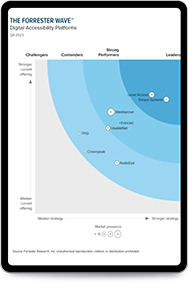Accessibility: A Critical Component of Modern Experience Design (XD)
Aug 10, 2022
Today, there are more than five billion internet users around the world. 85 percent of Americans are online every day—31 percent of them say they’re online “constantly.” We’ve transitioned to a digital-first world, with companies competing for our attention. As users, when a digital experience delivers the exact value we expect, it generates a lasting impact. We’re loyal to brands that make it enjoyable and easy to engage. And we return to them.But for many individuals with disabilities, online engagement is often anything but easy. More than 96 percent of the million most popular website homepages have accessibility errors in their coding and design. At best, these errors force a frustrating workaround for people with disabilities. At worst, a user with certain disabilities simply can’t interact with that site at all.When creating an experience, designers are continuously thinking about this user interaction. Leading designers understand this interaction is different for all of us, creating designs that are usable for all of us. And this is where digital accessibility becomes a critical component of effective experience design (XD). We spent some time with Senior UX Researcher, Wendy Garrett, from retail, e-commerce, and digital marketing agency The Stable, to better understand how she defines effective XD, the role of accessibility in design, and how The Stable helps companies build their digital experiences in a way that will better connect with consumers.
At a high level, how do you define experience design?
“To me, the term ‘experience design’ is all about design that starts with people—researching and understanding the core needs of people, and then building everything from there. It’s about making sure we’re including real-world experiences in the way we build things, and solving any problems someone may encounter. And as part of experience design, we have to remember, we’re not just trying to understand the core needs of some people, we’re designing to understand and meet the needs of all people.”
Is this where accessibility becomes part of the thinking?
“Most definitely, or it should anyway. Accessibility is all about equality of access and removing any barriers that could become problems, whether it’s a physical or digital experience. And I believe that as designers of digital experiences, in our predominantly digital society, we have a fundamental responsibility to create products and services that serve everyone equally. This includes the estimated 25 percent of the U.S. adult population that identifies as having a disability. If accessibility thinking is not part of design thinking, we’re underserving a significant percentage of the population. Organizations should absolutely prioritize accessibility if they haven’t already.”Forrester has identified accessibility platforms as one of the top ten technologies that underpin experience design, sitting at the top of the high business value category. Request the Q1 2022 Tech Tide.
Do you find more designers are thinking this way?
“I think that there’s been a definite shift over the past five years. We are more curious than we were, which is a good thing. We want to learn about each other, and we want to do better for each other. That has been driven in large part by the advocacy of the community of people with disabilities. I’ve started to see designers taking their roles as communicators and problem solvers a bit more seriously, and realizing that accessibility is not a ‘nice to have,’ but a ‘must have.’ We’ve got a long way to go, and a lot of educating to do, but I think together, we’re slowly figuring out how to build a design culture that’s more inclusive and accessible.”
Beyond designers, who else should be responsible for ensuring accessibility?
“I believe that creating an experience that’s enjoyable and will make a lasting consumer impact is everyone’s responsibility. If you’re a designer and already thinking this way, but the rest of the product development team isn’t, break down those silos. Get your product leaders, engineers, C-suite, and human resources colleagues excited about building products that will serve the needs of everyone.A good first step is to help colleagues better understand the way users with disabilities interact with digital experiences. Talk with different users. Ask questions. Get a feel for how they navigate a website or an app, and the challenges they face. When we’re more curious about different user needs, we’re more likely to prioritize building products that meet those needs. And naturally, this includes experiences that are also accessible.”
Can you share a bit more about The Stable and how you approach experience design?
“The Stable is a commerce agency that forges new pathways for brands to connect more authentically with their customers. We start every project by understanding the needs of the end user, and then we allow those needs to dictate our design. For us, you can’t have effective XD without accessibility. It’s fundamental to the products we create, and we’re proud to be partners with eSSENTIAL Accessibility (eA) to help us deliver on this commitment.”Learn why digital accessibility platforms like eSSENTIAL Accessibility’s top the “invest” category in Forrester’s 2022 Q1 Tech Tide on Experience Design.
Effective XD with eA
eA partners with digital agencies, SIs, MSPs and consultancies, providing these partners, and the brands they work with, a comprehensive digital accessibility solution. Our all-in-one eA Platform is a centralized hub for accessibility technology, tooling, testing, and reporting, with access to expert managed services such as manual evaluations, design evaluation, legal guidance, code-level remediation support, and expert-led training. It’s this critical combination of technology and servicesthat will support and sustain an organization’s successful accessibility program.
Subscribe for updates

